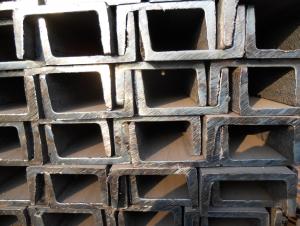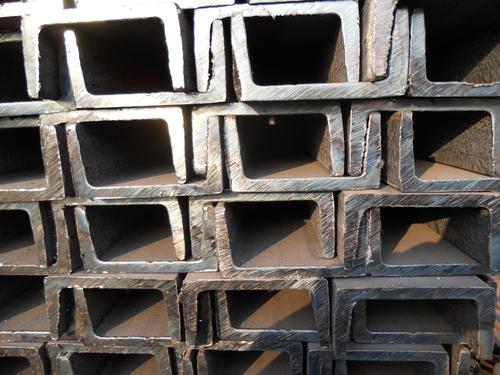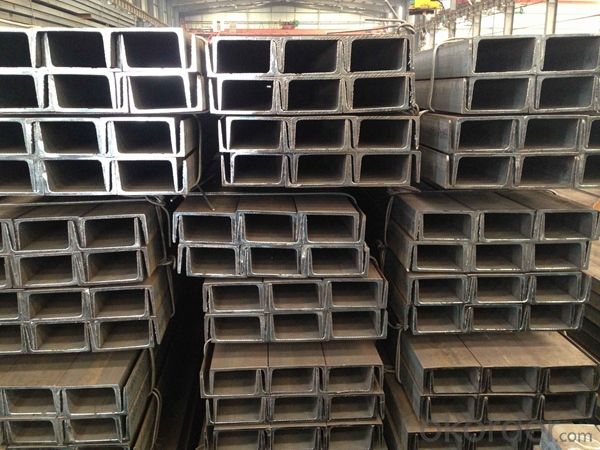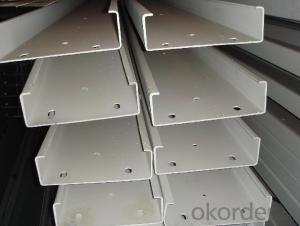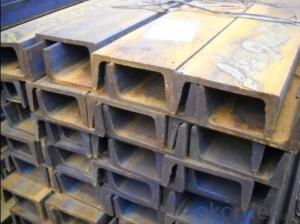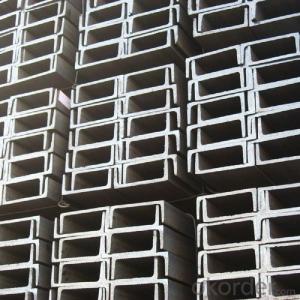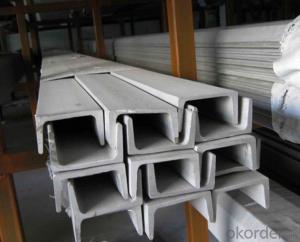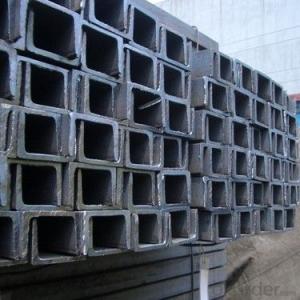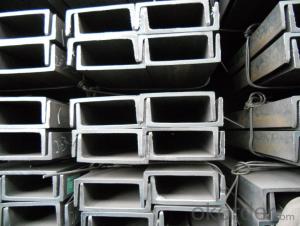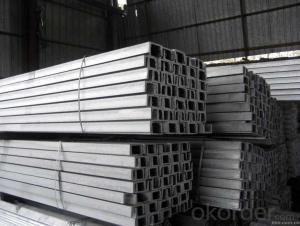SS400 JIS G3192.Steel Channel With High Quality
- Loading Port:
- China main port
- Payment Terms:
- TT or LC
- Min Order Qty:
- 25 m.t
- Supply Capability:
- 2000 m.t/month
OKorder Service Pledge
OKorder Financial Service
You Might Also Like
Product Description:
OKorder is offering SS400 JIS G3192.Steel Channel With High Quality at great prices with worldwide shipping. Our supplier is a world-class manufacturer of steel, with our products utilized the world over. OKorder annually supplies products to European, North American and Asian markets. We provide quotations within 24 hours of receiving an inquiry and guarantee competitive prices.
Product Applications:
SS400 JIS G3192.Steel Channel With High Quality are ideal for structural applications and are widely used in the construction of buildings and bridges, and the manufacturing, petrochemical, and transportation industries.
Product Advantages:
OKorder's SS400 JIS G3192.Steel Channel With High Quality are durable, strong, and resist corrosion.
Main Product Features:
· Premium quality
· Prompt delivery & seaworthy packing (30 days after receiving deposit)
· Corrosion resistance
· Can be recycled and reused
· Mill test certification
· Professional Service
· Competitive pricing
Product Description:
Specifications of Hot Rolled Channel Steel:
1. We are definitely speciallizing in manufacturing and supplying channel steel as per japanese standard, which is characterised with high mechanical strength and competitive prices.
Original Place | Tangshan, China | Brand Name | UINDA |
Standard | JIS G3192 : 1990 | ||
Material Grade | SS540 | ||
Sizes | 50mm to 200mm | ||
Sales Volume/Year | 3000MT | ||
Destination Area | Middle East, Africa, Southeast Asia | ||
2. The mechanical property of Hot Rolled Channel Steel in the table-1:
Grade | Yield Strength,N/mm² | Extension Strength N/mm² | |||
Thickness of Steel,mm | |||||
≦16 | >16-≦40 | >40-≦100 | >100 | ||
SS540 | ≧400 | ≧390 | - | - | ≧540 |
Table-1
3. The chemical composition of Hot Rolled Channel Steel as per SS540 in the table-2
Grade | Yield Strength,N/mm² | Extension Strength N/mm² | |||
Thickness of Steel,mm | |||||
≦16 | >16-≦40 | >40-≦100 | >100 | ||
SS540 | ≧400 | ≧390 | - | - | ≧540 |
Table-2
Trade terms: FOB, CFR, CIF
FAQ:
Q1: Why buy Materials & Equipment from OKorder.com?
A1: All products offered byOKorder.com are carefully selected from China's most reliable manufacturing enterprises. Through its ISO certifications, OKorder.com adheres to the highest standards and a commitment to supply chain safety and customer satisfaction.
Q2: How do we guarantee the quality of our products?
A2: We have established an advanced quality management system which conducts strict quality tests at every step, from raw materials to the final product. At the same time, we provide extensive follow-up service assurances as required.
Q3: How soon can we receive the product after purchase?
A3: Within three days of placing an order, we will begin production. The specific shipping date is dependent upon international and government factors, but is typically 7 to 10 workdays.
Images:
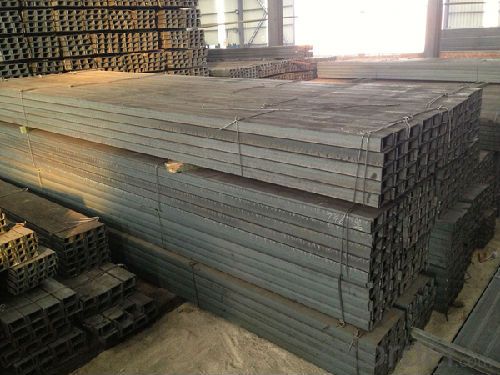
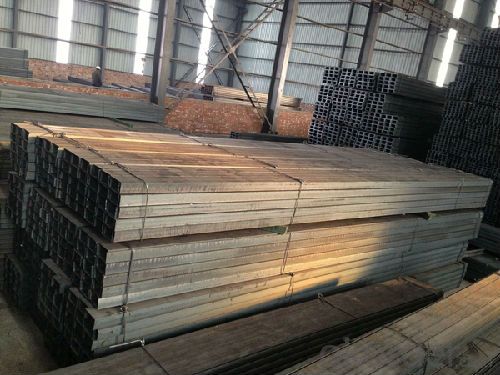
- Q: Channel steel, I-steel, round bar, angle steel, Fang Gang price is per ton to count or by rice? How about tons and meters? The formula is best
- Channel steel, I-steel, round bar, angle steel, Fang Gang price is to come to calculate the price per ton.
- Q: How do steel channels contribute to the overall safety of a project?
- Steel channels play a crucial role in enhancing the overall safety of a project in several ways. Firstly, these structural components provide robust support and reinforcement to various structures, such as buildings, bridges, and infrastructure projects. The strength and durability of steel channels make them capable of withstanding heavy loads and extreme weather conditions, minimizing the risk of structural failure or collapse. Moreover, steel channels are fire-resistant, which is a significant advantage in terms of safety. In the event of a fire, steel channels can withstand high temperatures for an extended period, offering valuable time for evacuation and minimizing the spread of flames. This fire resistance property makes steel channels highly suitable for projects where fire safety is a critical concern, such as high-rise buildings, industrial facilities, and transportation infrastructure. Another important contribution of steel channels to project safety is their ability to resist corrosion. Steel channels are typically made from galvanized or stainless steel, which are highly resistant to rust and corrosion. This resistance ensures the structural integrity of the channels over time, reducing the risk of deterioration and potential hazards. Consequently, projects utilizing steel channels can enjoy a longer lifespan and require less maintenance, ultimately enhancing safety and reducing the need for costly repairs. Additionally, steel channels offer versatility in design and construction. They can be easily customized and fabricated to suit specific project requirements, allowing for precise and secure connections between various structural elements. This versatility ensures accurate alignment and integration of components, minimizing the chances of structural instability or compromise. Lastly, steel channels provide excellent load-bearing capacity, enabling the distribution of weight and stress evenly across a structure. This even distribution of loads prevents localized points of weakness or excessive strain, thereby enhancing the overall stability and safety of the project. In conclusion, steel channels contribute significantly to the overall safety of a project by providing robust support, fire resistance, corrosion resistance, versatility in design, and excellent load-bearing capacity. By incorporating steel channels into construction projects, the risk of structural failure, fire hazards, and deterioration can be greatly minimized, ensuring the safety and longevity of the project.
- Q: Cautions for surface zinc spraying on channel steel
- In the liquid zinc galvanizing state, through physical and chemical processes is quite complicated, not only in the steel plating thick pure zinc layer, but also generate a Zn Fe alloy layer. This plating method not only has galvanized corrosion characteristics, and because of the zinc iron alloy layer. It also has strong corrosion resistance which can not be compared with galvanized. Therefore, the plating method is especially suitable for various strong acids, alkalis, fog and other corrosive environments.
- Q: Are steel channels suitable for use in the construction of utility poles?
- No, steel channels are not suitable for use in the construction of utility poles. Utility poles typically require materials that have specific properties such as high strength, resistance to weather and corrosion, and ability to withstand various loads. Steel channels may not possess all of these characteristics, hence other materials like wood, concrete, or composite materials are commonly used for utility poles.
- Q: You can use steel purlin
- It is better not to use C steel. The channel steel made of 1.2--3.0MM is too heavy and the price is high
- Q: What are the different types of steel channel connections for floor framing?
- For floor framing, there exist various types of connections for steel channels. 1. Welded Connections: The most commonly used connection for steel channel floor framing is welding. This involves welding the channels at the joints, resulting in a robust and long-lasting connection. Welded connections are suitable for heavy loads and high levels of vibration. 2. Bolted Connections: Another option is using bolts to connect the channels. This type of connection allows for easy disassembly and reassembly, making it ideal for situations where modifications or relocation may be necessary. Bolted connections are also more cost-effective than welded connections and can handle lighter loads. 3. Riveted Connections: Riveted connections involve using rivets instead of bolts to connect the channels. This type of connection offers a strong and secure bond and is often preferred for its traditional or aesthetic appearance. 4. Clip Connections: Clip connections involve using clips or brackets to hold the channels together. This type of connection is quick and easy to install and does not require welding or drilling. Clip connections are commonly used when quick assembly or potential future disassembly is desired. 5. Moment Connections: Moment connections are suitable when the channels need to resist bending moments or torsion. These connections provide a rigid bond between the channels, enabling effective load transfer. Moment connections are more complex and require meticulous design and installation. In summary, the choice of steel channel connection for floor framing depends on factors such as load requirements, project specifications, and budget. It is advisable to seek guidance from a structural engineer or professional to determine the most suitable connection type for your specific application.
- Q: What are the factors to consider when determining the appropriate width of a steel channel?
- When determining the appropriate width of a steel channel, several factors need to be considered. Firstly, the load-bearing capacity of the channel is crucial. The width of the channel should be sufficient to support the expected load without bending or buckling. The weight and distribution of the load, as well as any dynamic forces or vibrations, should be taken into account while calculating the required width. Secondly, the span length or distance between the supports is an important factor. Longer spans require wider channels to provide adequate support and prevent sagging or deflection. Thirdly, the material properties of the steel channel need to be considered. The strength and stiffness of the material influence the required width. Using steel with higher tensile strength or a higher modulus of elasticity may allow for narrower channel widths while maintaining the necessary structural integrity. Additionally, the intended use or application of the steel channel should be considered. Different applications may have specific requirements for the width of the channel. For example, in building construction, the width of steel channels used for beams or columns would be determined by structural design codes and standards. Furthermore, the fabrication and installation processes should be taken into account. The width of the steel channel should be practical for manufacturing, transportation, and installation purposes. It should be feasible to produce the desired width within the capabilities of the steel manufacturer, and it should be manageable to transport and erect the channel at the construction site. Lastly, cost considerations play a role in determining the appropriate width of a steel channel. Wider channels generally require more material, resulting in higher costs. However, using a narrower channel than required may compromise the structural integrity and safety, which may lead to additional costs in the long run. In conclusion, the factors to consider when determining the appropriate width of a steel channel include the load-bearing capacity, span length, material properties, intended use, fabrication and installation processes, and cost considerations. By carefully evaluating these factors, an appropriate width can be determined to ensure the structural integrity and functionality of the steel channel.
- Q: Can steel channels be used for HVAC duct supports?
- Yes, steel channels can be used for HVAC duct supports. Steel channels are strong and durable, making them suitable for providing structural support to HVAC ducts. They can be easily installed and offer stability and rigidity to the ductwork. Additionally, steel channels can withstand the weight of the ducts and any additional equipment attached to them, ensuring the proper functioning of the HVAC system.
- Q: Can steel channels be used for support columns?
- Yes, steel channels can be used for support columns. Steel channels provide strength, stability, and durability, making them a suitable choice for supporting heavy loads in construction and structural applications.
- Q: Do steel channels have any specific thermal expansion properties?
- Yes, steel channels do have specific thermal expansion properties. Like all materials, steel expands and contracts with changes in temperature. The thermal expansion of steel channels is primarily determined by the coefficient of linear expansion, which is a measure of how much the material expands per unit length per degree Celsius (or per unit length per degree Fahrenheit). The coefficient of linear expansion for steel typically ranges between 10 to 13 parts per million per degree Celsius (10-13 ppm/°C). This means that for every degree Celsius increase in temperature, a steel channel will expand by approximately 10 to 13 parts in a million of its original length. It is important to consider the thermal expansion of steel channels in various applications to ensure proper design and functionality. For example, in structures where steel channels are used, such as bridges or buildings, allowance must be made for the expansion and contraction of the channels to prevent stress buildup and potential damage. Expansion joints or other methods of accommodating thermal expansion are typically incorporated into the design to account for these properties. In summary, steel channels do exhibit specific thermal expansion properties, which are determined by the coefficient of linear expansion. Understanding and accounting for these properties is crucial in the design and application of steel channels to ensure their structural integrity and functionality in varying temperature conditions.
Send your message to us
SS400 JIS G3192.Steel Channel With High Quality
- Loading Port:
- China main port
- Payment Terms:
- TT or LC
- Min Order Qty:
- 25 m.t
- Supply Capability:
- 2000 m.t/month
OKorder Service Pledge
OKorder Financial Service
Similar products
Hot products
Hot Searches
Related keywords
